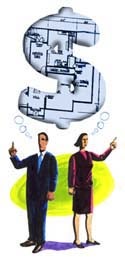The tragic earthquakes in Turkey and Taiwan finally have brought to the public’s attention the importance of well-enforced building codes as a way of reducing property damage and loss of life in a natural disaster. This is a problem that affects the United States, and not only in earthquake country. In 1992, Hurricane Andrew caused more than $15 billion worth of insured damage in Florida. It has been estimated that at least 25% of those losses could have been averted had structures met existing building codes. A confluence of forces is responsible for the lack of enforcement of building codes. Contractors and developers have economic incentives to build less expensive homes because they sell more easily. The problem is compounded because many individuals living in hazard-prone areas believe that disasters will not happen to them. For example, many residents affected by the flooding from Hurricane Floyd this year in mid-Atlantic states commented that they had felt no need to purchase flood insurance because they couldn’t imagine the water rising to the levels that it did. In addition, when it comes to strengthening their property to reduce future losses, people often don’t feel it is a good investment. They don’t see the protective measures as increasing the value of their houses over the life of their properties. Many families also feel that they do not have the funds for this purpose. One way to help the enforcement of building codes is to offer property owners economic incentives so they will demand that their structures be constructed to withstand future earthquakes or other natural disasters. Developers and contractors then will find that it makes good sense and means dollars for them to design safer homes. A constructive step in this direction is to involve insurance industry and mortgage lenders as partners to provide incentives for the adoption of cost-effective loss-reduction measures. By coupling insurance with loans for safer structures, property owners would then lobby for better protection and well-enforced building codes because it makes economic sense. For example, suppose you could improve the design of a house so that, should a severe earthquake occur, the damage to the structure would be $30,000 less in claim payments from earthquake insurance than it would have been without the new design. Suppose that experts estimate that a severe earthquake will occur in this area once in 100 years. This translates into a 1 in 100 chance per year. An insurer who is charging a premium for earthquake insurance based on risk should want to reduce the annual cost by $300 (1/100 x $30,000) to a property owner who adopted this measure. Suppose the cost for improving the house design was $1,500. The property owner may be reluctant to incur the costs. However, if the $1,500 were translated into a 20-year loan attached to the mortgage at an annual interest rate of 10%, then the annual payment would be only $170. This cost is $130 less than the $300 savings in the insurance premium. How could banks and insurers work more closely to encourage property owners to demand improved building design? Currently, banks require homeowners insurance coverage as a condition for a mortgage. In earthquake-prone areas, there should be sound reasons to add this coverage as a condition for a loan. The insurance industry also should want to work closely with contractors and hire inspectors to ensure that the appropriate measures were installed before they lowered premiums. State insurance regulators would have to set premiums that reflect the future risk of damage based on the best judgment of experts. If these arrangements were in place, there would be a clamor by property owners for more disaster-resistant structures, simply because it would save them money on their total mortgage payments–$130 in the above example. There is precedent for using financial institutions to encourage property owners to adopt measures that benefit themselves and society. Under provisions of the 1992 Energy Policy Act, if the home to be purchased or refinanced is certified as energy efficient, it qualifies for a larger mortgage loan. A second type of loan is one that is folded into mortgage payments for financing energy conservation improvements. In the case of natural disasters, what is becoming increasing clear is that future damage costs are likely to be higher than it is today, and that the current system is not working. By more actively involving both the insurance industry and financial institutions as promoters of well-enforced building codes, we have a better chance of encouraging property owners to demand safer structures and developers and contractors to build them. This article appeared in the
Looking for more insights?
Sign up to stay informed about our latest article releases.



